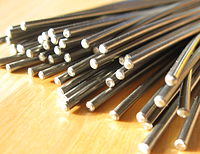
Photo from wikipedia
Abstract Shape memory alloy (SMA) wires integrate functionality into composites and encourage the design and creation of adaptable smart structures. Upon the application of cyclic loading, however, the functional properties… Click to show full abstract
Abstract Shape memory alloy (SMA) wires integrate functionality into composites and encourage the design and creation of adaptable smart structures. Upon the application of cyclic loading, however, the functional properties of SMA wires can decrease significantly resulting in functional fatigue. To simulate this cyclic behavior, an SMA material model with logarithmically evolving and temperature dependent functional fatigue is developed. Pre-stretch is also considered to simulate structures with embedded pre-stretched SMA wires. The material model is fit to a set of tests (constant strain, isobaric, isothermal tension, isothermal cyclic tension) performed on SMA wires. The fit demonstrates an excellent agreement with the experimental results with minor discrepancies. The simulations show the capabilities of the model to evolve the residual strains, residual stresses, hysteresis and hardening in the presence of cyclic loading. Additionally, the isobaric actuation behavior and the reorientation response of the model are validated using experiments from the literature. The fitted and validated model is then used to simulate the response of a rubber specimen with two embedded SMA wires subjected to cyclic thermal loading. The simulated rubber specimen illustrates the loss of functionality after the applied cyclic loading and highlights the importance of not exceeding design temperature loads. Furthermore, the complex thermomechanical loading in the SMA wires displays the importance of including temperature or stress dependence for defining functional fatigue.
Journal Title: International Journal of Solids and Structures
Year Published: 2022
Link to full text (if available)
Share on Social Media: Sign Up to like & get
recommendations!